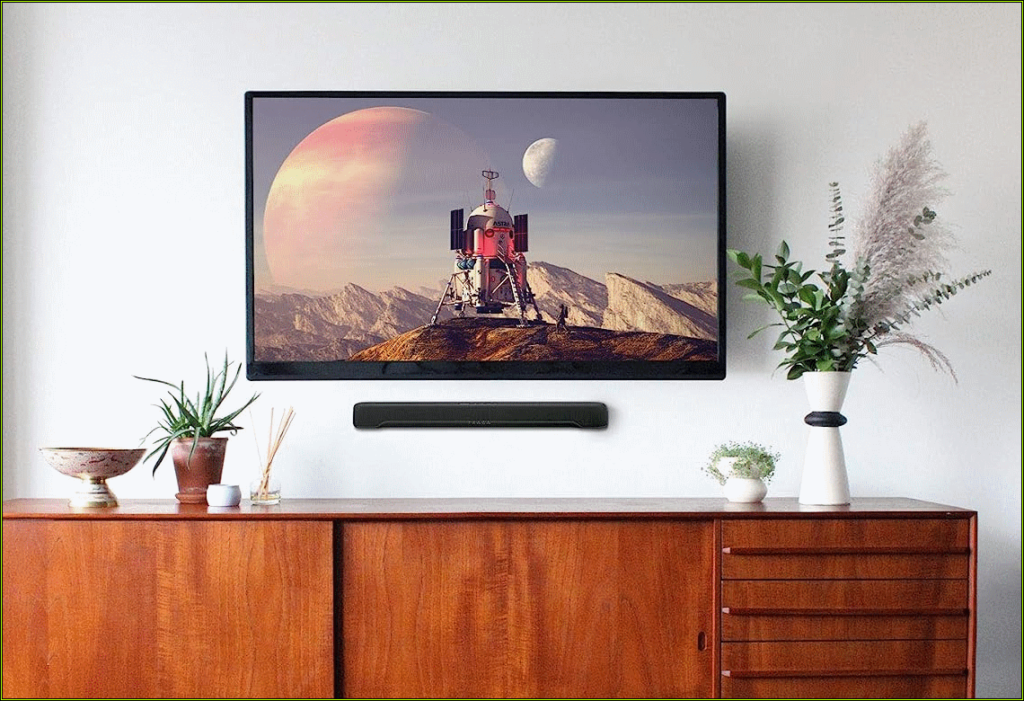Finding the Best Affordable Soundbar (Oct 2023)
I’ve decided to invest in my audio experience recently, and I’d like to pay it forward! For today’s post, my goal is to help you find the best affordable soundbar that fits your needs, your space, and your budget.
In a world where gaming has become an integral part of our lives, the quality of audio is just as important as the visual experience. While modern flat-screen TVs and monitors have come a long way in terms of picture quality, they often fall short when it comes to sound. This is where soundbars come to the rescue!
Is A Soundbar Worth it?
You probably might be asking yourself, “what exactly is a soundbar“? And more importantly, why is it even worth your time? After all, your TV has speakers built in, to you’d think that getting a soundbar would be a waste of money, right?
I like to think of a soundbar kind of like having cheese on your hamburger. Sure, you could enjoy your meal without it, but the additional flavor just makes the burger as a whole taste a lot better.
I was hungry when I wrote this article, so forgive my weird analogy.
What is a soundbar?
To put it short and sweet, a soundbar is a sleek and compact audio device that connects to your TV and significantly enhances the audio output. Whether you’re watching your favorite movies or enjoying a gaming session, a soundbar can make a world of difference in your audio experience.
Soundbars are typically designed to sit just below or above your TV, and they come in various sizes and shapes to accommodate different television and room configurations. They are equipped with multiple built-in speakers and amplifiers, all packed within a single enclosure. Some soundbars also include a separate subwoofer for added bass and depth in sound.
How does a soundbar work?
Soundbars work by using a combination of various speaker components to project audio in a way that enhances the listening experience. Here’s a simplified breakdown of how they function:
- Speaker Configuration: Soundbars typically contain multiple speaker drivers within a single unit. These drivers are carefully positioned to create a wide soundstage, which can simulate surround sound without the need for multiple speakers.
- Audio Enhancement: Soundbars use digital signal processing (DSP) technology to process and optimize the audio signal. This can include adjusting the sound’s equalization, dynamics, and spatial characteristics to produce clear and balanced audio.
- Virtual Surround Sound: Many soundbars feature technology that creates a virtual surround sound effect. By bouncing sound off walls and reflecting it towards the listener, they can mimic the immersive audio experience of a full-fledged surround sound system.
- Subwoofer Integration: Some soundbars come with a wireless or wired subwoofer that enhances the bass response. This added depth and impact can make action scenes in movies more thrilling and music richer.
- Connectivity: Soundbars are designed to be easily connected to your TV and other devices. They can use various connectivity options, such as HDMI, Bluetooth, Wi-Fi, and even optical or RCA cables, depending on the model.
Benefits of using a soundbar
A lot of people seem to think they need a big home theatre system to enjoy their games, but that would also cost an arm and a leg. The good news is you don’t have to break the bank to get top-notch sound quality. This is of course the big reason why I recommend a soundbar; they’re more affordable, plus they take up less space than a home theatre system!
Setting up a soundbar is a breeze. It usually involves plugging it into your TV and power source, and you’re ready to go. Some models even come with wall-mounting options for a seamless look depending on your living room setup.
Things to look for in a Soundbar
When it comes to finding the best affordable soundbar, it’s important to consider the key features that will make a difference in your audio experience. While budget-friendly options can provide excellent audio enhancement, not all soundbars are created equal. Here are some essential features to keep in mind while making your decision:
Sound Quality
- Audio Output: The primary purpose of a soundbar is to improve audio quality. Look for a soundbar with clear and balanced audio output. Check for features like Dolby Digital, DTS, or other audio enhancement technologies to ensure a rich, immersive sound.
- Surround Sound Capability: Some soundbars are equipped with virtual or simulated surround sound technology. This can create a more immersive audio experience, making it feel like sound is coming from all around you, even without rear speakers. I suggest looking for Dolby Digital, Dolby Atmos, DTS:X, or spatial audio support
- Adjustable Equalization: The ability to adjust the sound settings to your liking is crucial. Look for a soundbar with customizable equalization settings, which allows you to tweak bass, treble, and other audio elements to suit your preferences.
Connectivity Options
- HDMI Ports: HDMI connectivity is crucial for modern soundbars. It allows for high-quality audio and video transmission. Make sure the soundbar has enough HDMI ports for all your devices, like gaming consoles, Blu-ray players, and streaming devices.
- Bluetooth and Wi-Fi: Wireless connectivity options, such as Bluetooth and Wi-Fi, enable you to stream music from your smartphone or tablet. This versatility allows you to enjoy music without needing a TV or other connected devices.
- Compatibility with Various Devices: Check that the soundbar is compatible with a wide range of devices, including your TV, gaming consoles, and other audio sources. Universal compatibility ensures you won’t run into connectivity issues.
Size and Design
- Fit with Your TV: Consider matching up the brand name of your soundbar with the brand of your TV. Not only does it help compliment your television’s aesthetics, some TV makers implement feature that seamless integrate with your soundbar. while others can be mounted on the wall.
- Mounting Options: Some soundbars are designed to sit below the TV, so if you prefer a wall-mounted soundbar, make sure the model you choose includes the necessary hardware for easy installation. Wall-mounted soundbars can help save space and create a sleek, modern look in a room.
- Build Quality: Look for a soundbar with solid build quality and durable materials. A well-constructed soundbar not only looks better but is likely to provide better sound quality and longevity.
Top Brands and Models
Now that we’ve covered the key things to consider, it’s time to look at some of my top picks for affordable soundbars. I’ll go over a few select brands that excel in all aspects, each with its unique features and benefits. Whether you’re a movie enthusiast, a music lover, or a gamer, there’s a soundbar out there to suit your needs.
Yamaha SR-C20A – Best Affordable

- Features:
- Small, light, and compact. The soundbar measures a mere 23
- Built-in subwoofer
- Wall-mountable with built-in keyholes
- HDMI and built-in Bluetooth connectivity.
- Pros:
- Simple setup with HDMI, optical or aux connections
- Bluetooth streaming for your music and podcasts
- Great for small spaces
- Cons:
- Limited connectivity options (few HDMI ports).
- Bass output may not be the best for movies.
Yamaha SR-C30A – Budget Friendly Upgrade

- Features:
- Compact two-channel stereo with a separate subwoofer
- Excellent audio output with clear dialogue and bass.
- 4 sound modes to match your content and your mood: Standard, Stereo, 3D Movie and Game.
- HDMI and Bluetooth connectivity for versatile usage.
- Pros:
- Simple setup with one cable: HDMI ARC, Optical or Aux.
- Bluetooth connnectivity
- Virtual surround sound for an immersive experience.
- Cons:
- Bass output may still not be enough.
Samsung HW-Q990B – Best for Dolby Atmos

- Features:
- Wireless Dolby Atmos
- Up-firing rear speakers for immersive sound.
- 3 HDMI ports and Bluetooth connectivity for versatile usage.
- Syncs with Samsung TVs.
- Pros:
- Wireless setup; no need for cables connecting the speakers together.
- Amazing sound quality.
- Cons:
- It costs about the same as a traditional home theatre system
Vizio M-Series Elevate 5.1.2 Soundbar

- Features:
- Dedicated surround speakers.
- Motorized speakers that tilt up and bounce the sound off the ceiling to simulate sound from above
- 2 HDMI ports and Bluetooth connectivity for versatile usage.
- Sleek and modern design that complements any TV setup.
- Pros:
- One of the more affordable Atmos soundbars.
- Virtual surround sound for an immersive experience.
- Cons:
- No option for Wi-Fi, meaning you can’t cast stream music from your phone
- It’s still quite expensive
These are just a few examples of the top brands and models in the world of affordable soundbars. When choosing the right soundbar for your home, consider your specific needs, the size of your room, and your budget. Each of these models offers different features and advantages, ensuring that there’s an option to cater to your unique audio preferences.
Tips for Setting Up Your Soundbar
Whether you’re a tech-savvy enthusiast or a newcomer to the world of soundbars, these tips will help you get the most out of your new audio equipment:
Placement and positioning
- Position your soundbar directly under or above your TV. Make sure it’s centered for the best sound distribution. If wall-mounted, ensure it’s at ear level when seated.
- If your soundbar is wall-mounted, keep it a few inches away from the wall to prevent sound reflections.
- If your soundbar includes a subwoofer, place it on the floor for optimal bass distribution. Experiment with subwoofer placement to find the sweet spot for your room.
Connection to your TV and other devices
- If your TV and soundbar support HDMI ARC (Audio Return Channel), use this connection for the best audio quality and streamlined operation.
- If your TV lacks HDMI ARC, use an optical or RCA cable to connect the soundbar. Make sure to adjust your TV’s audio settings accordingly.
- Set up wireless connections to stream music from your smartphone or tablet. Ensure both your soundbar and mobile device are in pairing mode.
Sound settings and calibration
- Explore the sound modes provided by your soundbar. Some models offer presets for movies, music, sports, and more. Choose the one that suits your current content.
- Fine-tune the bass and treble settings to match your audio preferences. This can significantly impact the overall sound quality.
- Some soundbars offer room calibration features. Use them to optimize audio based on your room’s acoustics.
- Make sure to turn off the TV’s speakers. Sometimes mixing the TV’s built-in speakers with a soundbar may cause sound echoing
The Bottom Line
Wrapping things up, it is pretty clear that soundbars will help make your audio experience just as great as the visual experience. As I mentioned earlier, you can still make do without one, but if you invest in an affordable soundbar, you’ll find that the sound quality will be much better than that of your TV.
The best thing about soundbars is the fact that they bring crystal-clear sound, cinematic surround effects, and booming bass to your TV. From movies to music and gaming, a well-chosen soundbar can transform the way you enjoy your media. They also cost a lot less than a traditional surround sound system!
When it comes down to choosing one, always remember to consider your specific needs, room size, and budget when selecting a soundbar. With the information and tips I’ve provided in this buying guide, you are ready to make an informed decision and find the perfect soundbar that fits your lifestyle.
Until next time, I hope this has been helpful, and whereever you live in the world, have fun, and happy gaming!
~ Ken

